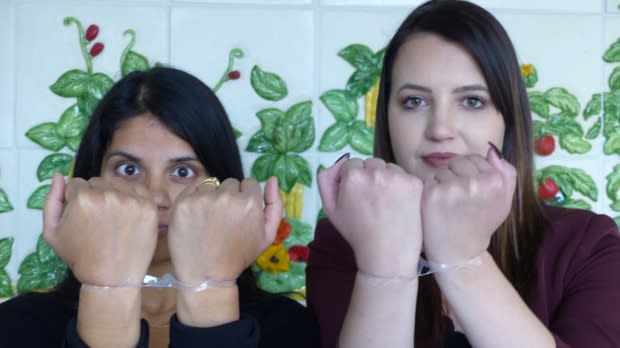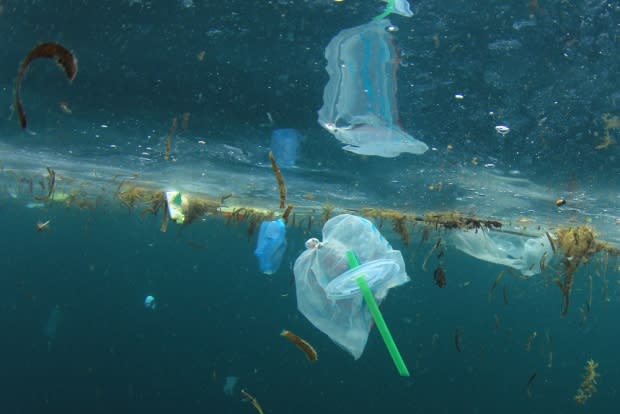We spent 2 weeks trying to free ourselves of single-use plastics
Have you ever cried in a grocery store?
One of us came close, after visiting three in a row that didn't have lettuce that wasn't wrapped in plastic.
Canadians don't just buy a lot, we waste a lot. Canada leads the developed world in per capita production of garbage. It's not an area you want to be a world leader in.
As part of our experiential journalism series In Your Shoes, we accepted a challenge from a producer to go two weeks without any single-use plastics.
By the time we were done, many crying emojis had been sent back and forth as we commiserated via text.
For our challenge, we allowed ourselves access to plastic products we already had, like toothbrushes, shampoo and opened food in our homes, but we had to find a new solution if we needed to replace any of those items.
Before beginning, we talked to Saskatoon resident Meg Dorwart, who lives waste-free.
Three years ago, she cut out plastics, followed the next year by cutting out waste. Her advice? Go easy on yourself, and do what you can. Making better choices starts with an awareness of your consumption and reducing over-consumption.
"Honestly that's the hard step, just being mindful of it, every time you're purchasing something," she said. "It's just habit to buy things, right?"

Dorwart warned us food would be tricky.
When you think about giving up plastics, you might think about pop, chips and granola bars. But you might not think about strawberries, kale, peppers and peanut butter.
We know we didn't.

For both of us, going plastic-free meant shopping around. It meant visiting as many as four stores to complete our grocery lists, whether it was produce, bread, bulk foods or cheese.
Even then, there were failures along the way.

Say you take a jar with you and go to a bulk store to buy oatmeal. When you buy milk to go with it, whether it's in a jar or a carton, the lid will still be made of plastic.
Or maybe you buy spaghetti in a box and congratulate yourself on your great choice. But then you notice there's a little plastic window to show you what the pasta looks like. Do we really need the window? We all know what pasta looks like!
Going plastic-free also requires a lot more prep work. One of us is vegetarian and the other is vegan, but our favourite quick tofu and veggie meat options were out the window.

Lunches were a new torture. Soloducha is used to grabbing food near work if she doesn't have time to pack herself something in the morning.
"Now the very thought of this makes my palm sweaty," she said. "One day, I ordered a salad in a cardboard to-go box, and asked the employee not to give me the plastic fork she was offering.
"But when I went to eat it, I realized the dressing was in its own container."

Whitfield had to pack lunches for her family of five without relying on any lazy or prepackaged snacks. She made buns, muffins and cookies ahead of time. Still, there were times when she desperately wished she could throw some goldfish or crackers from a plastic bag into the kids' lunch boxes.
"With an already limited diet, three picky kids and no plastics, there were times when I looked at my increasingly bare pantry and I just wanted to lie down in a quiet, dark space and cry."

As we went along the challenge, we found several sources of motivation.
Soloducha was scrolling on Facebook one day when she came across a post showing photo after photo of marine wildlife caught up in plastic in the ocean.
"It was highly motivational at a time when I was asking myself, 'WHY AM I DOING THIS?' " she said.

We know this is a huge problem. Most plastics are not recycled and wind up in landfills, lakes, parks and oceans. Eight million metric tonnes of plastic find their way into the ocean each year and 90 per cent of seabirds have plastics in their stomach.
A recent waste audit by Greenpeace found that five companies in Canada contribute to the majority of plastic waste, with the top two being Nestlé and Tim Hortons.
As much as these two companies were criticized, the problem goes far beyond them. It goes to individual plastic coffee pods or tea in a plastic-wrapped box with each of the tea bags individually wrapped in plastic. It goes to dishwashing tabs in a bag, individually wrapped in foil. It goes to aisles and aisles of shopping we couldn't even begin to approach these last two weeks.

By the end, we realized we'd done pathetically. We were hungry, angry and still not at the point where we could fit our trash from the week into a mason jar.
But Dorwart makes a good point — if people are making an effort, they should feel proud of what they're doing.
"If they don't have the passion to drive them all to waste-free, they shouldn't feel guilty about that. Because right now, it's not as convenient as I think it should be," she said of reducing waste.
Right now, there's a lot of pressure on consumers to do all the work, said Dorwart. She said businesses could help share in the burden by making eco-friendly choices easier.
In the meantime, what are we supposed to do as consumers when the big guys might not budge?
Whatever we can.
Take a mug when you grab coffee, put your groceries in a reusable bag or buy bulk as often as you can. But don't be too hard on yourself.
Going plastic-free is definitely not easy. But we believe that caring and making an effort could never be considered a waste.

